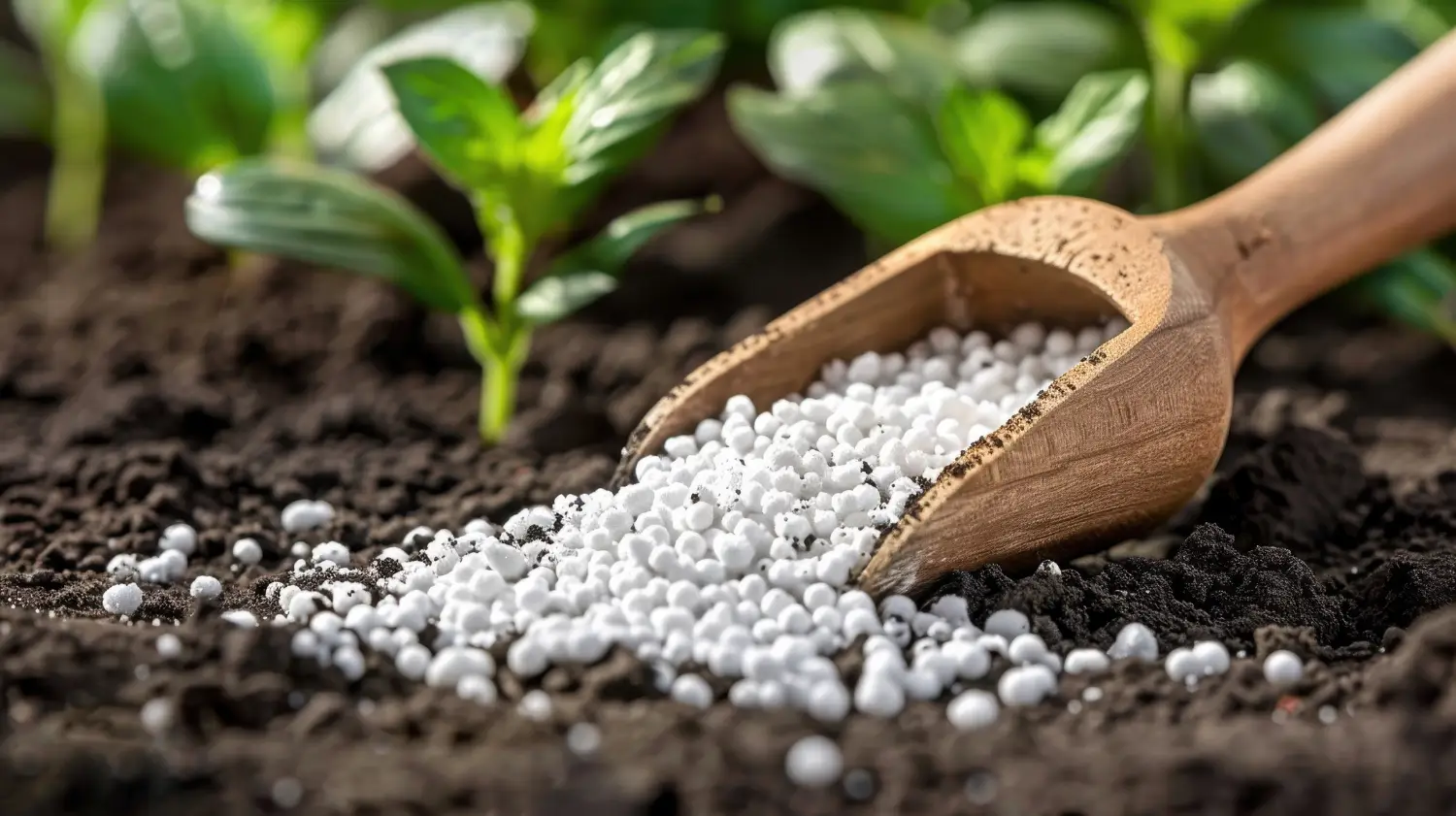
April 29, 2025

Plants require an adequate balance of nutrients in order to thrive, resist disease, and ensure a healthy harvest. Calcium and nitrogen are two essential nutrients for plants. Calcium nitrate (Ca(NO₃)₂) is one of the best fertilizers that provide both.
Calcium nitrate is a fast-acting, water-soluble fertilizer that provides plants with calcium to strengthen cell walls and nitrate nitrogen to assist with photosynthesis. For these reasons, it’s commonly used by farmers, gardeners and horticulturists to promote plant health, strengthen roots and increase crop yields.
Calcium nitrate is used by a lot of farmers to prevent nutrient deficiencies. It prevents blossom end rot in tomatoes and peppers, and tip burn in leafy greens. Growcycle provides several calcium nitrate fertilizer options to support plant growth and deter deficiencies.
Calcium nitrate (Ca(NO₃)₂) is a water-soluble fertilizer supplying two vital nutrient components to plants, namely calcium (Ca) and nitrate nitrogen (NO₃). This nutrient solution is commonly used in agriculture, hydroponics, and gardening to support healthy plants, strengthen roots, and prevent nutrient deficiencies.
This consists of calcium ions (Ca²⁺) and nitrate ions (NO₃⁻). This allows for high solubility in water, enabling quick and effective nutrient uptake by the plants. Calcium nitrate provides readily available nitrogen (essential for plant growth) in addition to calcium, unlike other calcium sources such as calcium sulfate (gypsum) or calcium carbonate (lime).
Calcium nitrate is different from other fertilizers because it delivers both calcium and nitrate nitrogen in a form that plants can easily absorb. Here’s how it stacks up against some common fertilizers:
Calcium nitrate is especially beneficial for calcium-deficient crops like tomatoes, peppers, and lettuce since it have both; provides readily available nitrogen levels and gives the calcium needed for strong cell walls.
There are three forms of calcium nitrate available for different farming and gardening uses:
Calcium is important for plant growth and development, providing building blocks for stronger cell walls, supporting root growth, activating enzymes, and providing protection from stress. It helps to fortify the overall structure and function of the plant.
The presence of calcium gives strength to the cells of the plant. The rigidity of the cell walls serves as protection against diseases and preventing physical damage for these plants. Without enough calcium, these walls are compromised, and plants are more susceptible to fungal infections and disorders like blossom end rot in tomatoes and peppers.
Roots are needed to absorb the water and nutrients in the soil. Calcium ensures proper cell division and elongation, thus facilitating strong root systems. Calcium uptake is crucial for nutrient absorption, germination, plant growth, and resistance to soil-borne diseases.
Calcium activates enzymes that regulate many plant metabolic processes. These enzymes control catabolism and anabolism of carbohydrates and other compounds, including those necessary for a plant’s overall health, cell growth, for nutrient transport, and hormone production. Without calcium, these processes are slowed down, which causes a lack of nutrients and growth in the plants.
Calcium assists plants in resisting environmental stress, such as drought, heat and severe weather conditions. It helps strengthen the tissues of plants making them less prone to wilting or damage from external stressors. Calcium also counteracts the detrimental impact of excessive soil sodium levels, thereby enhancing the salt tolerance of plants.
Nitrate (NO₃⁻) is one of the main sources of nitrogen available to plants and is important for plant growth and productivity. It improves photosynthesis, increases protein synthesis and prevents the symptoms of nitrogen deficiency.
Nitrate is the form of nitrogen with the highest plant uptake rate. In contrast to ammonium-based nitrogen, which must be converted into usable compounds by plants before being taken up, nitrate is immediately available to plants, serving as an immediate energy source for plant growth. It means that plants grow quickly and effectively.
Nitrogen is a key element of chlorophyll, the green pigment found in leaves that absorbs sunlight for photosynthesis. If there isn’t enough nitrogen available, plants can’t make enough chlorophyll; leaves appear pale and yellow because less energy is created.
Nitrate is required to assemble amino acids, which make up proteins. Proteins are essential for growth, enzyme functioning and overall development of plant. Nitrate nitrogen fosters vigorous growth, resulting in increased crop yield and better fruit and seed production.
Nitrogen-deficient plants display visible symptoms of deficiency, such as:
The calcium nitrate fertilizers available in retail are very versatile in terms of application methods, including soil application, foliar spray, and hydroponic solutions. When applied correctly can give the plants the calcium and nitrogen required to build stronger plants and prepare them to be able to withstand more pressure and potentially have greater yield.
Calcium nitrate can be applied directly to soil to provide nutrients for plant roots. There are two common methods:
Dosage for soil application is recommended as:
Calcium nitrate can also be diluted and sprayed directly on the leaves of the plants, as leaves are able to absorb calcium quickly, making it useful for treating calcium deficiencies. This technique is effective for fruiting and leafy plants that need a calcium lift and fast. To prepare foliar spray:
The best crops for foliar feeding are:
Calcium nitrate is probably the most widely used of the nutritional salts used in hydroponics. It is highly soluble and provides the correct nutrition balance needed for plant growth.
Hydroponic crops that take advantage from calcium nitrate include most of them:
Calcium nitrate fertilizers give plants two essential nutrients which are calcium and nitrogen, both of which are key to producing vigorous plants, high-quality fruit, and eliminating deficiencies such as blossom end rot. A detailed overview of the top 4 products is listed below
Jack's Calcium Nitrate Part B is a water-soluble fertilizer to encourage calcium uptake and vigorous leaf growth. Free from additional physiologically reactive elements, it is a wholesome source of calcium and nitrate nitrogen that enables growers to fine-tune the nutrient supply for individual crops or growth periods.
Combined with Jack's Part A FeED, it provides a fully available nutrient solution for balanced nutrition of the plant. This product is ideal for hydroponics, greenhouse, or soil growing environments. The 1 kg size is perfect for smaller applications, and the 25 lb choice is best for bigger operations.
Calcium and nitrogen are essential elements needed by plants to grow, so a fertilizer like Hi-Yield Calcium Nitrate is specially designed to provide it. Specifically, this fertilizer will help vegetable gardens avoid disorders such as blossom end rot in tomatoes, peppers, and other fruiting crops.
It is readily applied in granular form and quickly releases nutrients to improve soil structure and strengthens plant cell walls. It makes sufficient and economic calcium readily available, which helps prevent the abundance of common calcium deficiency problems, leading to good, healthy crops.
Hi-Yield Ammonium Calcium Nitrate is a strong mix of calcium and nitrogen, both of which are plant essentials. It is perfect for the vegetable garden, especially tomatoes and peppers.
It is critical in fighting blossom end rot, a widespread problem due to calcium deficiency when the growth of the fruit is rapid. It can be used as a soil side-dress or foliar spray, offering flexible options to promote optimal plant health and yield.
YaraLiva Calcium Nitrate is a fully water-soluble, nitrogen and calcium fertilizer. A free-flowing, fine granular or prilled, completely water-soluble material free of insolubles, suitable for application through all fertigation systems. In the presence of this product plants receive a steady amount of nutrients for their growth, thus they become more vigorous and stress resistant.
Calcium nitrate fertilizer should be used according to best practices that maximize efficiency and nutrient absorption on the part of farmers and gardeners to achieve optimal results. The right way to apply, the right dose and the right time are critical to plant proper growth and preventing nutrient deficiencies.
The application, handling, and storage of calcium nitrate fertilizer must be performed correctly to guarantee the product is safe, which carries over to the quality of the end product, and that it will not affect the environment. Calcium nitrate is hygroscopic and highly soluble, so must be handled and applied carefully.
Can calcium nitrate burn plants?
Yes, overapplication or application of foliar sprays during hot, sunny conditions can result in leaf burn. Always stick to the recommended dosages, and use it on the skin either very early in the morning or in the late evening.
Is calcium nitrate safe for organic gardening?
No, calcium nitrate is a synthetic fertilizer and is not allowed in organic production. In practice, organic equivalents of calcium are gypsum, lime, or bone meal.
How does calcium nitrate improve soil health?
It improves soil structure by decreasing soil compaction, increasing aeration, and ridding the soil of acidic pH to ensure better nutrient absorption.
Farmers, gardeners, and hydroponic growers use calcium nitrate as a fast-acting fertilizer. It works in soil, foliar sprays and hydroponic systems, aiding plants in quickly absorbing nutrients. Apply calcium nitrate correctly and avoid many headaches caused by issues such as tomato blossom end rot and lettuce tip burn. It also allows plants to develop healthier roots and yield greater harvests. Find high-quality calcium nitrate fertilizers for healthy plant growth to prevent nutrient deficiencies at Growcycle.
Disclaimer: This material is for informational purposes only and should not be relied on for legal, medical, financial, or any other form of professional advice.